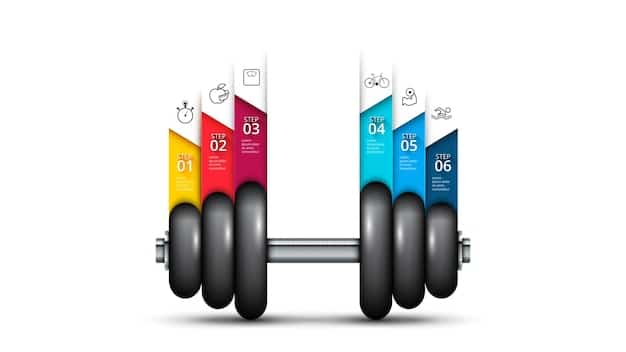Vertical Jump Height: Data-Driven Comparison of Strength Training Programs

Achieving significant improvements in vertical jump height necessitates a data-driven approach to strength training, rigorously comparing the efficacy of diverse methodologies like plyometrics, resistance training, and specific periodization models to identify optimal programming for athletes aiming to enhance explosive power and performance.
For athletes across various disciplines, the ability to jump higher often translates directly into enhanced performance. Whether it’s a basketball player needing to dunk, a volleyball player spiking, or a track and field athlete soaring over hurdles, an impressive vertical jump is a testament to explosive power. This article presents a Comparison/Analysis: A Data-Backed Comparison of the Effectiveness of Different Strength Training Programs for Increasing Vertical Jump Height, offering insights grounded in scientific research to help you optimize your training.
Understanding the Science of Vertical Jump
The vertical jump is more than just raw strength; it’s a complex athletic movement demanding a powerful interplay of muscular force, speed, and neuromuscular coordination. At its core, the jump relies on the stretch-shortening cycle (SSC), where muscles are rapidly stretched (eccentric phase) before quickly contracting (concentric phase) to produce a powerful, elastic recoil. Optimizing this cycle is crucial for maximizing jump height.
To truly understand how different training programs impact vertical jump, we must first appreciate the underlying physiological mechanisms. Muscle fiber type, specifically the prevalence of fast-twitch fibers, plays a significant role in explosive movements. These fibers are designed for quick, powerful contractions, though they fatigue rapidly. Therefore, training methodologies that recruit and develop these fibers are often highly effective.
Neuromuscular Adaptations and Power Output
Beyond muscle size and strength, neurological adaptations are paramount. The nervous system’s ability to efficiently recruit motor units and synchronize muscle contractions dictates power output. Training that enhances these neural pathways can lead to substantial improvements even without significant increases in muscle mass.
- Rate of Force Development (RFD): This refers to how quickly an athlete can generate force. A higher RFD means more explosive power, directly impacting vertical jump height.
- Intermuscular Coordination: The synergy between different muscle groups working together, such as glutes, quads, and hamstrings, is vital for a fluid and powerful jump.
- Intramuscular Coordination: The ability of individual muscles to activate a greater number of muscle fibers simultaneously.
Power, defined as force multiplied by velocity, is the direct determinant of jump height. Therefore, strength training programs must not only build maximal strength but also develop the capacity to express that strength explosively. This often means focusing on movements performed at high velocities.
Understanding these foundational principles allows for a more discerning evaluation of various training programs. Without this scientific lens, it’s easy to fall prey to anecdotal evidence or fads. Our goal is to provide a data-informed perspective, drawing from studies that quantify the effectiveness of different approaches.
Plyometric Training: The Explosive Edge
Plyometric training is arguably the most recognized and widely applied method for improving vertical jump height. It involves exercises where muscles exert maximum force in short intervals, with the goal of increasing power and speed.
The essence of plyometrics lies in the stretch-shortening cycle. Exercises like box jumps, depth jumps, and bounding train the body to store and release elastic energy efficiently. When performed correctly, plyometrics can significantly enhance the nervous system’s ability to activate muscles rapidly, leading to greater explosive power.
Optimizing Plyometric Intensity and Volume
Data suggests that the effectiveness of plyometrics is highly dependent on appropriate intensity and volume. Too little, and the adaptive stimulus is insufficient; too much, and the risk of injury increases, outweighing any potential gains. Studies often recommend 2-3 sessions per week, with a focus on quality over quantity.
- Depth Jumps: Initiating a jump from a box, landing, and immediately rebounding upwards. This maximizes the eccentric pre-stretch, amplifying the rebound.
- Box Jumps: Jumping onto a box, focusing on minimizing ground contact time and maximizing hip drive.
- Bounding/Hopping: Repetitive single or double-leg jumps over distance, emphasizing horizontal power transfer.
Research consistently demonstrates that plyometric training alone, or in combination with other methods, yields significant improvements in vertical jump. One meta-analysis, for instance, found that plyometric training produced average increases of 7-10% in jump height among trained and untrained individuals. The key is progressive overload and proper technique to mitigate injury risk. Athletes must gradually increase the complexity, intensity, and volume of plyometric exercises as their adaptation progresses.
Resistance Training: Building the Foundation of Strength
While plyometrics focus on power and speed, resistance training provides the essential foundation of maximal strength necessary for a powerful jump. Without adequate strength, an athlete’s ability to generate force quickly, even with efficient plyometrics, will be limited.
Traditional resistance exercises like squats, deadlifts, and lunges are crucial for developing the primary movers involved in jumping: the quadriceps, hamstrings, and glutes. These exercises build absolute strength, which is the ceiling for an athlete’s potential power output. A stronger athlete has a greater capacity to produce force, which can then be expressed explosively through plyometric or other power training.
Key Lifts for Vertical Jump Enhancement
Research consistently highlights specific resistance exercises that directly translate to vertical jump improvements. The emphasis should be on compound movements that engage multiple joints and muscle groups simultaneously, mimicking the dynamic nature of a jump.
- Back Squat: A fundamental lower-body exercise that develops strength in the glutes, quads, and hamstrings. Varying squat depth can influence muscle activation patterns.
- Deadlift: Excellent for posterior chain development, including the glutes and hamstrings, which are critical for hip extension during a jump.
- Olympic Lifts (Cleans, Snatches): These complex lifts require high levels of power, coordination, and technique. Data often shows strong correlations between Olympic lift performance and vertical jump height due to their explosive nature.
Data-backed studies frequently show that a well-structured resistance training program can lead to substantial increases in vertical jump. For example, a program focusing on heavy basic lifts (e.g., 80-90% of 1-rep maximum) has been shown to increase jump height by approximately 5-8% over an 8-12 week period. The challenge lies in integrating resistance training effectively with other methods to avoid conflicts in training adaptations and prevent overtraining.

The Synergy of Concurrent Training: Resistance & Plyometrics
Many contemporary strength and conditioning protocols advocate for concurrent training, which involves systematically integrating both resistance and plyometric training within the same training cycle. The rationale is to harness the benefits of both modalities: resistance training builds foundational strength, while plyometrics refine explosive power and the efficiency of the stretch-shortening cycle.
The academic literature provides compelling evidence for the efficacy of concurrent training. Studies comparing concurrent programs to resistance-only or plyometric-only programs often find that the combined approach yields superior results for vertical jump height. This suggests that the strength gains from resistance training provide a higher “force potential,” while plyometrics train the body to express that potential rapidly and efficiently.
Optimizing Concurrent Program Structure
The challenge in concurrent training is finding the optimal balance and sequencing to maximize synergistic effects and minimize potential interference. Research explores various models, including performing resistance and plyometrics in the same session, on separate days, or even alternating between blocks of focused training.
- Same Session vs. Separate Days: Some studies suggest better outcomes when resistance training and plyometrics are performed on separate days to minimize fatigue interference. However, if performed in the same session, plyometrics are often recommended before heavy resistance training to ensure maximal neural drive for the explosive exercises.
- Periodization Models: Block periodization, where distinct phases focus on different qualities (e.g., strength phase followed by a power phase), can be effective. Another approach is undulating periodization, which varies training intensity and volume frequently.
- Volume and Intensity Management: Careful monitoring of total training load is crucial to prevent overreaching or overtraining, as concurrent training places significant demands on the neuromuscular system.
A meta-analysis synthesizing results from multiple studies concluded that concurrent training programs resulted in greater vertical jump increases (typically 10-15% over 8-12 weeks) compared to single-modality training. This highlights the importance of a well-designed integrated approach. The specific ratio and sequencing of strength and power training should be individualized, considering the athlete’s current training status, time availability, and recovery capacity.
Advanced Training Modalities: Beyond the Basics
While plyometrics and traditional resistance training form the bedrock of vertical jump programs, advanced modalities offer additional avenues for performance enhancement. These methods often target specific aspects of power generation or provide novel stimuli for adaptation.
One such modality is complex training, which pairs a heavy resistance exercise with a biomechanically similar plyometric exercise. For example, a heavy set of squats immediately followed by box jumps. The theory is that the heavy lift elicits post-activation potentiation (PAP), transiently increasing muscle twitch force and making subsequent explosive movements more powerful.
Utilizing Emerging Training Techniques
Velocity-based training (VBT) is gaining traction, where repetitions are performed at a specific velocity rather than focusing solely on load. By using devices that measure bar speed, VBT allows athletes to optimize their training for power output, ensuring that movements are always performed explosively.
- Complex Training: Pairing heavy squats with box jumps to exploit PAP. This typically involves a brief rest period (e.g., 3-5 minutes) between the strength exercise and the power exercise.
- Weighted Jumps/Jumping Squats: Performing jumps or jump squats with light to moderate external load to increase force production. The load should allow for maximal velocity.
- Eccentric Overload Training: Emphasizing the lowering (eccentric) phase of a lift with supramaximal loads, potentially enhancing the stretch-shortening cycle’s elastic properties.
Data supporting these advanced methods often shows promising results. For instance, studies on complex training have demonstrated superior gains in vertical jump compared to traditional strength or power training alone, often leading to improvements of 3-5% beyond what standard methods achieve. Similarly, VBT has been shown to optimize power output, as athletes train specifically at velocities that correspond to peak power. While these methods are effective, they often require a higher level of coaching expertise and athlete experience to implement safely and effectively.
Periodization and Program Design: The Master Plan
The effectiveness of any strength training program for increasing vertical jump height ultimately hinges on its periodization—the systematic planning of training to maximize performance at specific times while minimizing injury and overtraining. A well-designed periodization model ensures progressive overload, allows for recovery, and strategically integrates various training components.
Linear periodization, while common, might not always be optimal for sports requiring sustained power development. Undulating periodization, which varies training intensity and volume on a daily or weekly basis, often allows for greater flexibility and can be more effective for maintaining high levels of both strength and power throughout a training cycle.
Key Principles of Effective Program Design
Beyond the choice of exercises, the manner in which they are integrated into a comprehensive program is critical. Load, volume, rest periods, and exercise order all play significant roles in determining adaptation.
- Progressive Overload: The constant demand for the body to adapt to increasing stress, whether through more weight, reps, sets, or more complex movements.
- Specificity: Training should be specific to the demands of the vertical jump, meaning exercises that mimic the movement pattern and involve similar muscle groups and contraction types.
- Recovery and Deloads: Adequate recovery is essential for adaptation. Strategic deload weeks or active recovery sessions can prevent accumulated fatigue and promote supercompensation.
Data from long-term athlete development programs consistently underscores the importance of a structured approach. Athletes following well-periodized programs typically report greater and more sustainable gains in vertical jump height compared to those with unstructured training. For example, a study comparing different periodization models found that a properly structured undulating program led to 12-18% increases in vertical jump over 16 weeks, outperforming linear models in some cases. This emphasizes that simply doing exercises isn’t enough; the overall training plan must be carefully conceived.

Conclusion: A Holistic Approach to Vertical Jump Enhancement
When comparing the effectiveness of different strength training programs for increasing vertical jump height, the overwhelming data suggests that a multi-faceted and strategically periodized approach yields the most significant and sustainable results. No single training modality holds all the answers; rather, the synergistic integration of various methods appears to be the optimal path.
Plyometric training is indispensable for developing explosive power and refining the stretch-shortening cycle, while traditional resistance training provides the critical foundation of maximal strength. Concurrent training, when properly implemented, allows athletes to harness the benefits of both, often leading to superior outcomes. Advanced modalities like complex training and velocity-based training offer specialized stimuli for pushing performance boundaries.
Ultimately, the most effective program is one that is individualized, progressively overloaded, and meticulously periodized to account for the athlete’s current level, goals, and recovery capacity. By combining scientific principles with practical application, athletes can unlock their full vertical jump potential, elevating their performance in any sport demanding explosive lower-body power.
| Key Point | Brief Description |
|---|---|
| 🚀 Plyometrics Training | Enhances explosive power via the stretch-shortening cycle with exercises like box jumps and depth jumps. |
| 💪 Resistance Training | Builds foundational strength in lower body through squats, deadlifts, and Olympic lifts. |
| 🤝 Concurrent Training | Combines resistance and plyometrics for synergistic gains, often yielding superior vertical jump increases. |
| 📈 Periodization & Design | Systematic planning (linear, undulating) and principles like progressive overload are crucial for sustained improvements. |
Frequently Asked Questions About Vertical Jump Training
▼
For optimal results, 2-4 training sessions per week are generally recommended, focusing on a balance of strength, power, and recovery. The specific frequency depends on your current training level, recovery capacity, and overall athletic schedule. Beginners might start with 2-3 sessions, while advanced athletes could handle more.
▼
Yes, weight training is highly essential. It builds the foundational strength necessary for producing high forces, which is a key component of explosive power. Exercises like squats and deadlifts increase maximal strength, providing a higher “ceiling” for your power output, which can then be expressed through plyometrics.
▼
Plyometrics are crucial for enhancing explosive power and the efficiency of the stretch-shortening cycle. They train your muscles to exert maximum force in minimal time, improving the speed and reactivity of your jump. Exercises like box jumps and depth jumps are fundamental for translating strength into explosive height.
▼
While structured jump training (plyometrics) is highly effective, you can certainly improve some components of vertical jump through general strength and power training. However, to truly maximize your jump height, incorporating sport-specific jumping movements and plyometrics is vital for neuromuscular adaptation and skill acquisition.
▼
Significant improvements can typically be observed within 8-12 weeks of consistent, well-structured training, with gains ranging from 5% to 15% or more. Individual progress varies based on baseline fitness level, genetics, recovery, and program adherence. Sustained, long-term commitment often yields the most dramatic results.
Final Thoughts on Elevating Your Vertical Jump
In summary, the journey to a higher vertical jump is a blend of scientific understanding and consistent, intelligent application. While various training programs offer distinct advantages, the cumulative evidence points towards an integrated approach that systematically combines foundational strength development with explosive power training. Athletes seeking to maximize their aerial prowess should embrace a periodized plan that includes both resistance exercises and plyometrics, potentially incorporating advanced techniques like velocity-based training for precision. Ultimately, the commitment to such a data-backed methodology promises not just incremental gains, but a transformative leap in athletic performance.





